About Mrs. Frey: link, link, and link. She has also written a number of articles and book reviews for Pacific Horticulture. Articles since 2004 can be read online here (type her name in the search field), including this 2009 article about the Melissa.
So who's Melissa?
"We chose the name “Melissa” because Melissa officinalis, or Lemon Balm, is an herbaceous plant that has been considered a favorite bee plant for a very long time. Also, in Greek mythology, Melissa is the name of one of the nymphs that fed Zeus honey as an infant while hiding him from his father, Cronus. When Cronus discovered this, he turned her into a worm. After Zeus came into power, he changed her into a queen bee, not being able to change her from an insect form. Melissa is a Greek word meaning honeybee."More, from the Garden's website:
"The Melissa Garden is a honeybee sanctuary in Healdsburg, California, at the western side of the Russian River Valley. Two acres of gardens planted with honeybee forage are situated in the center of a pristine 40-acre ranch that is lush with native vegetation. The Melissa Garden is a new project that began in the fall of 2007. It is being created to provide honeybees with a place to live natural lives, insulated from known stressors, and nourished in a beautiful setting."(Speaking of the beautiful setting, on my way there this morning, I drove right by Layanee's favorite wine country B&B, the Raford Inn. She blogged about staying there in December 2008.)
The Melissa is open to the public one day a month for tours and education. Kate gave us a nice lesson on honeybees, a subject about which I know relatively little. You will not be surprised to learn that Wikipedia has a good page on beehives, but did you know certain types of beehives are illegal in the United States? Illegal beehives!
"Skeps and other fixed-frame hives are no longer in wide use (and are illegal in many countries) because the bees and the comb cannot be inspected for disease or parasites without destruction of the honeycomb and usually the colony." (Wikipedia)However, according to Kate, people in many places outside the US still keep honeybees in fixed-frame hives.
This visit today was especially poignant in the aftermath of a recent mass killing of bees at a community garden here in San Francisco. Very sad.
Moving on...
The tour starts in the parking lot, with a sculpture by Sebastopol husband-and-wife team Patrick Amiot and Brigitte Laurent.
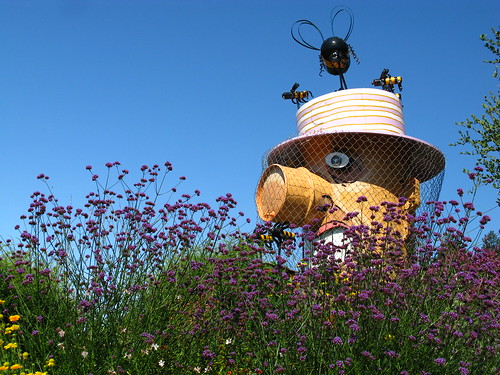
And from here we move in to the first garden.

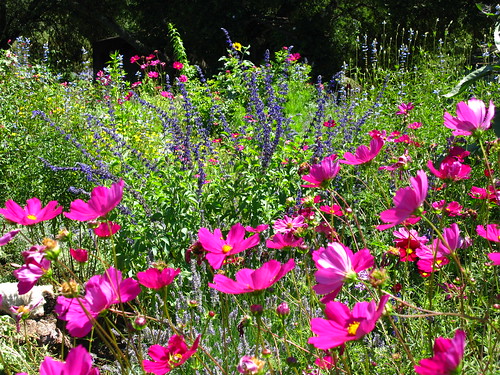
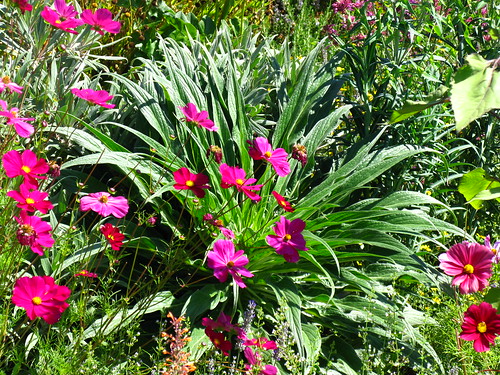
We saw beehives distributed throughout the gardens. I think there were at least ten of them.

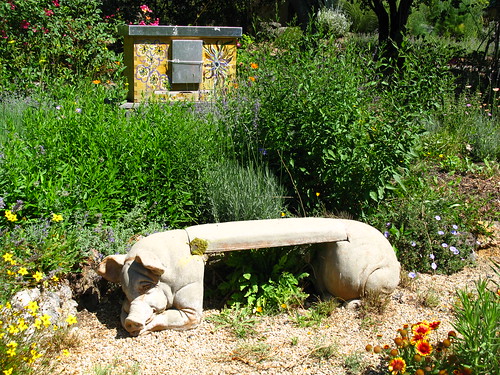
Claire and Elayne took amazing pictures right next to one hive, but I kept a respectful distance. (Also check out Elayne's picture of a bee-mimicking clearwing moth sipping Verbena bonariensis.)
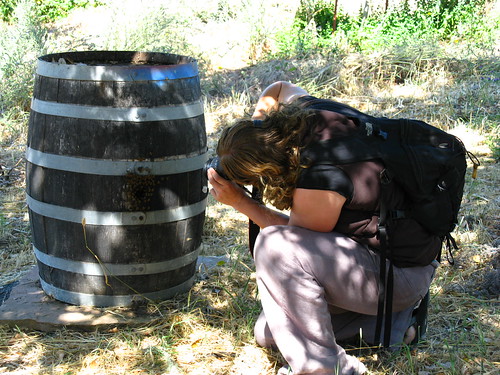
I love fountain-ponds like this.

Let pieces of cork-board (or wine corks!) float in your pond for your honeybee's drinking comfort.
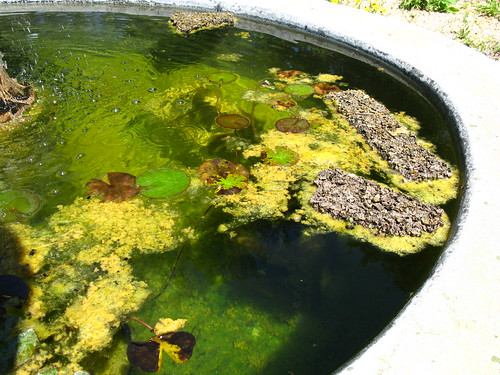
Also let wildflowers volunteer in your garden's gravel paths. I love that.
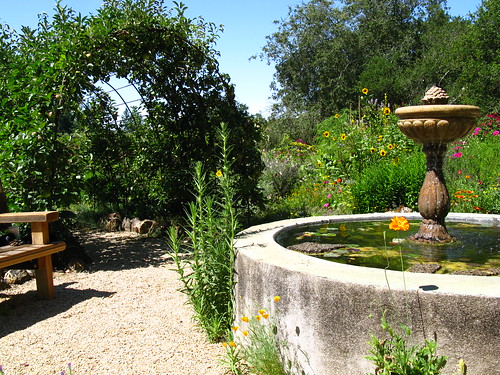
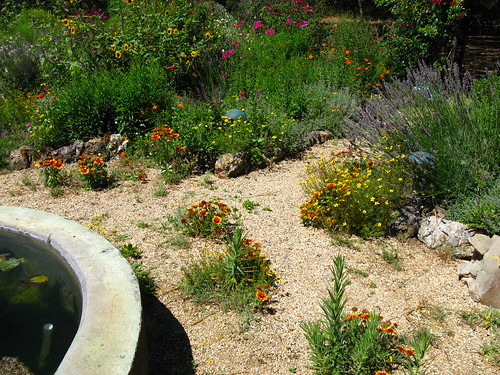
There's a rebar pergola supporting apples and pears behind the fountain. I firmly believe garden fruit trees should be kept small enough to reach the tree's highest-hanging fruit with an outstretched arm. Okay, you can have a step-ladder if you're petite.

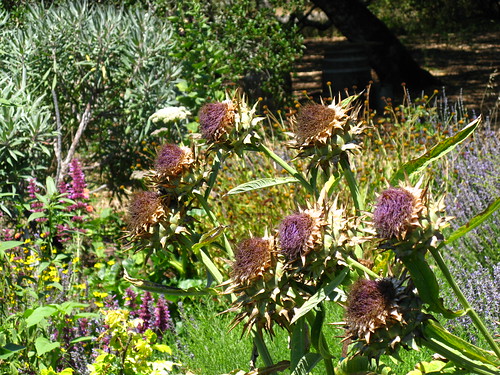

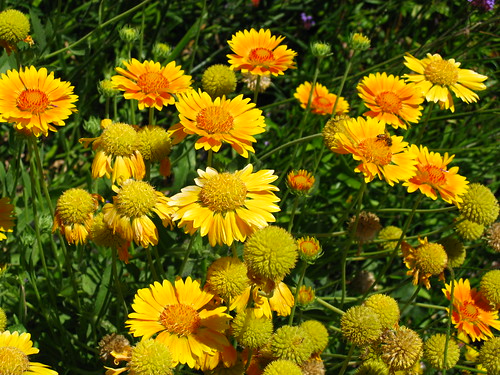
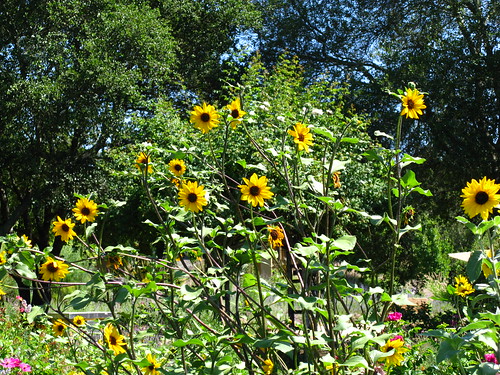
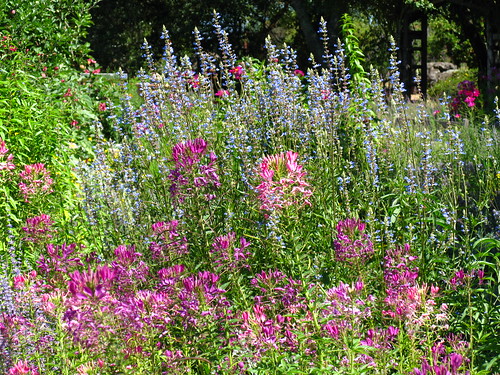
I made two new plant finds on this trip, including Calamintha nepetoides. Do you know about this plant? I gather many people do...
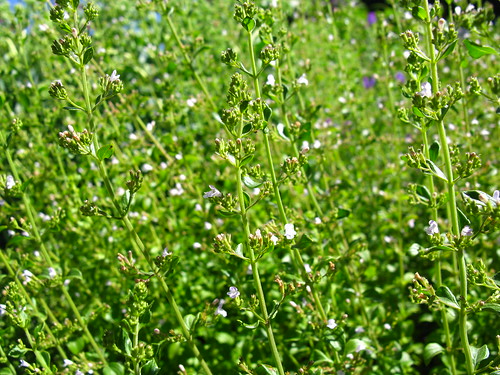
Xris said pollinators, especially small native bees, "swarm it" in his Brooklyn garden. I must have some. The calamint enhanced everything it grew with.
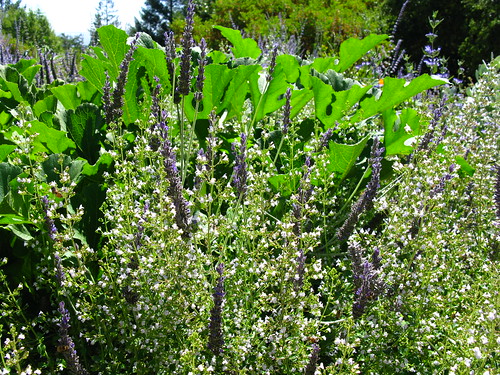
My other new plant is the tall, slender, vertical just left of the phormium below, Helianthus giganteus.
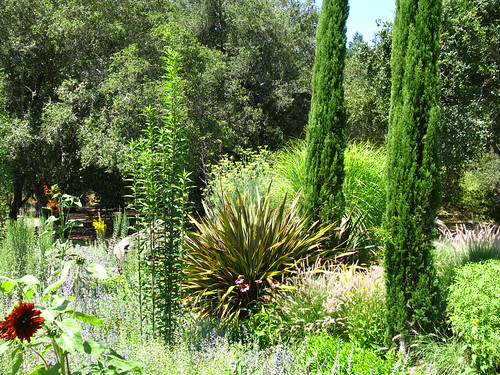
This perennial sunflower comes from the eastern US. Do you grow it? Tell me about it in the comments. We don't have a lot of perennial sunflowers in the trade, but those that we do have all come from you know who.
By this point we've moved away from the boisterous bee garden and into the more formal (but still very bee-friendly) California-style gardens Kate designed for the areas around the house.
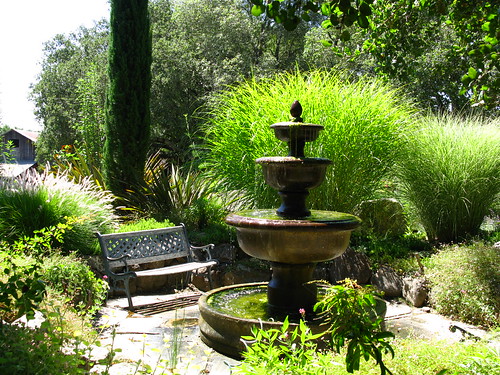
There were some more fountains and a stunning pool.
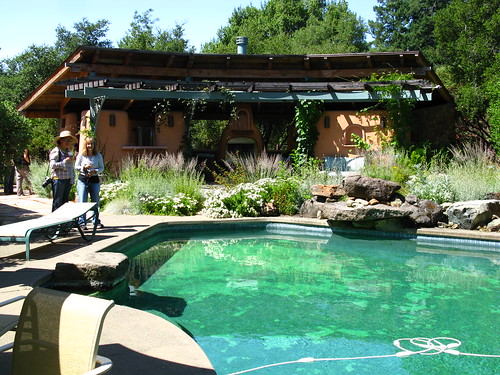
Elayne and I went a little camera crazy here.

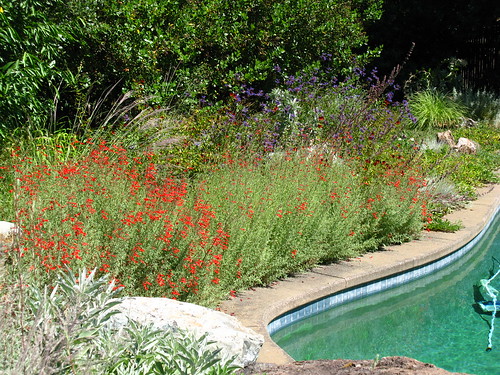

A bed behind the pool house--white yarrow, more Calamintha, California coast buckwheat (Eriogonum latifolium)--held all of our attention for a good half an hour.
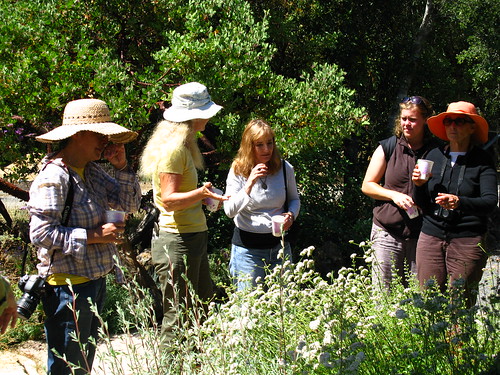
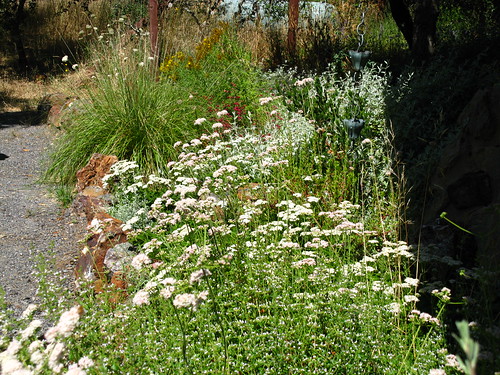
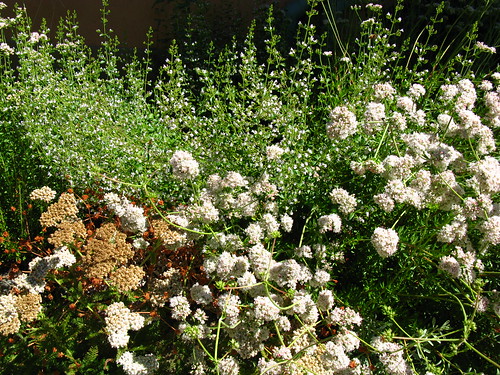
More plants for the California-native white garden...
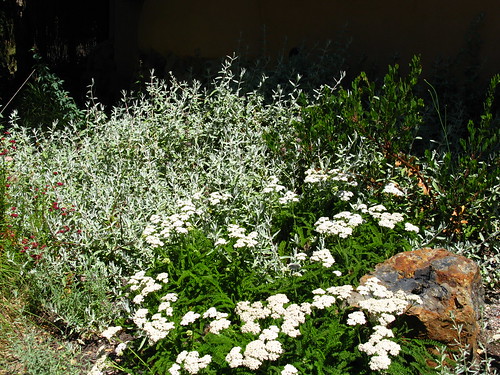
The light food offering held our interest too... Offer your garden visitors a tahini and honey spread for crackers and lemon balm, lemon verbena, chocolate mint tea. You will hold people's interest too.
I hope it's okay to show a few pictures of the pool house...I don't know if this would be part of the Melissa Garden's public tour. I'm generally unmoved by the whole lifestyle design thing, but the pool house was so lovely, even I was swooning.

Yeah, I could relax here.
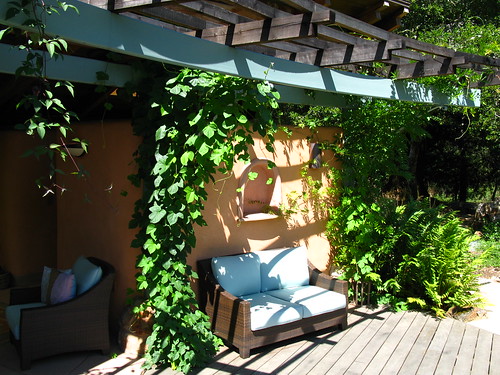
But we're not done. There's something to see on driveway behind the house...
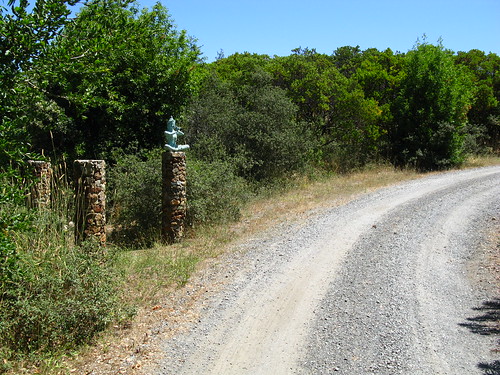
Who can resist a path into the woods.

Where does it lead?

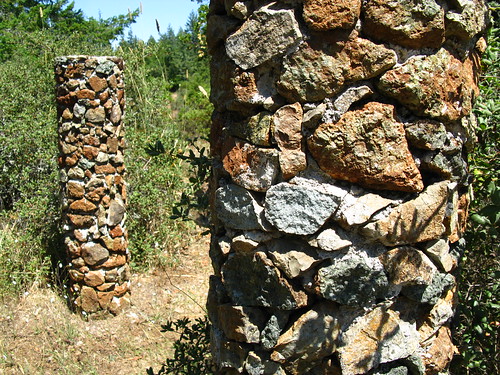
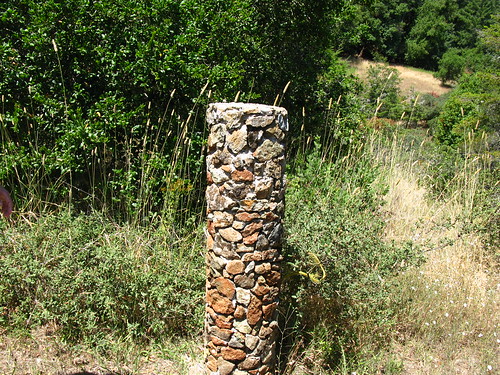
Kate, and puppy, urging us on...

And here we are.

Well, we knew it was a labyrinth. I didn't want to give it away.

The spent Allium seedheads shimmered in the light...

while the ubiquitous Hemizonia congesta ssp. sparkled in sun and shade.

It was a suitably magical place to end our tour.
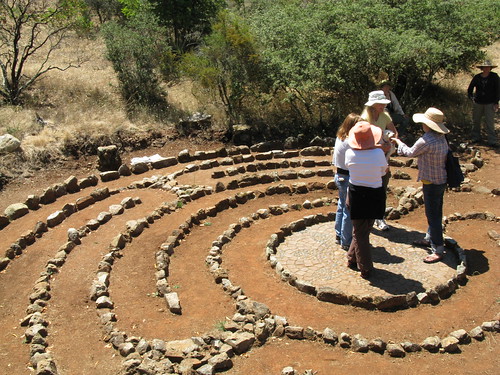

13 comments:
Amazing! I was excited to learn about floating corks in a water feature, I'm doing that immediately. Relaxing place indeed. (Except for all those pollinators! :)
What a great tour -- and useful for me to see some summer-blooming plants for the bees. I get lots of bees on the ceanotus in spring, but summer is always a little dry, well, except for the eriogonums, which attract all pollinators...
Thanks for the photos!
What an amazing place! We'll definitely have to check it out one of these days. Beautiful tour pics.
Looks like you found another great garden to take us to. I really like it when the landscaping is taken right up to the pool's edge.
Calamint is a staple at the garden center and for our landscapers. We keep it with the things that are drought hardy for us (it is has been put to the test these past weeks). Whenever I see it I can't help running my hands through it to stir up the aroma.
Interesting! If Calamint's much available here, it's never caught my eye before. That's a little indictment of my designing skills I suppose, not to recognize the use of a plant like that. Anyway, Claire told me they tried selling it at Annie's but there weren't many takers. And it grew so fast in the 4" pots they they typically sell plants in that they couldn't maintain it.
Skeps are a very primitive form of beehive, one that doesn't allow for hive inspections, or non-destructive honey harvests. Because a beekeeper cannot access the inside of the skep without tearing apart the bees' home, there's no way of checking for many of the diseases that plague bees, in the skep method.
Sandy Mush Nursery used to have lots of different calamints, including some great variegated ones. Haven't checked their catalogue lately but they're still in business. That was a wonderful tour, and thanks for including all the links to check out.
Outstanding! Thanks for taking us along on this tour.
What an amazing/inspiring place! I loved everything about it - especially the garden growing right up to the pool! Thanks for sharing.
Spectacular!!! I'm going to spend hours on these photos. Wonderful labyrinth, just so stunning and inspiring. Wow. Wow. Wow!!
WOW- how beautiful! What a neat opportunity for you guys- and you took amazing photos as usual! Thanks for the tour!!!!
Thanks for taking us along for this tour. Beautiful shots.
There are nearly 20,000 known species of bees in seven to nine recognized families,[1] though many are undescribed and the actual number is probably higher. They are found on every continent except Antarctica, in every habitat on the planet that contains insect-pollinated flowering plants.
Ground Bees
Post a Comment